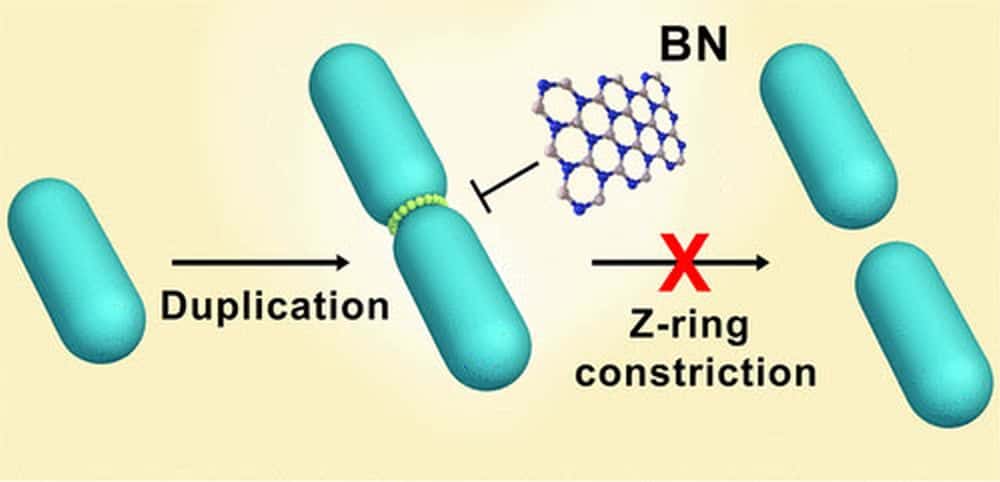
[Image above] Boron nitride nanosheets exhibited antibiotic-like activity to antimicrobial-resistant bacteria in a recent study. Reprinted with permission from Pan et al., ACS Nano. Copyright 2022 American Chemical Society.
By Laurel Sheppard
More than 2.8 million antibiotic-resistant infections occur in the United States each year, according to the CDC, leading to more than 35,000 deaths. In our attempts to keep people safe, though, we are inadvertently driving another crisis.
The overuse and misuse of antibiotics in treating infections is a leading cause of antibiotic-resistant germs. Infections caused by such germs significantly impact U.S. health care costs. In 2021, the CDC estimated that treating infections for six multidrug-resistant germs cost more than $4.6 billion.
Though secondary treatments are available, they can cause serious side effects, such as organ failure. Care and recovery can take much longer as well, sometimes up to months.
In 2016, Congress approved $160 million for the CDC to fight antibiotic resistance, which increased to more than $200 million as of fiscal year 2021. The CDC now has a website dedicated to this dilemma.
Scientists are investigating a variety of materials for their potential as antimicrobial agents, including
- Inorganic nanoparticles (e.g., gold, silver, copper, silica, iron oxide, zinc oxide, titanium dioxide, magnesium oxide),
- Carbon-based nanomaterials,
- Two-dimensional materials like graphene,
- Layered double hydroxides, and
- Graphitic carbon nitride (g-C3N4).
Some of these materials, such as graphene oxide, face the limitation that they cannot tell the difference between bacteria and mammalian cells, which could lead to damage of healthy organs. Fortunately, a new study led by researchers at Soochow University in China found boron nitride nanosheets do not face this limitation.
Boron nitride features unique lamellar, reticular, and tubular morphologies and physicochemical properties that make it attractive in numerous and varied fields, including adsorption, catalysis, hydrogen storage, thermal conduction, insulation, and radiation protection, among others.
Regarding biocompatibility, a study by Australian researchers found it depends on boron nitride’s size, shape, structure, and surface chemical properties.
Antivirals vs. antibiotics: What’s the difference?
One reason for the misuse of antibiotics in treating infections is the failure to identify when antivirals should be used instead.
Bacteria and viruses are different types of germs that can cause illness. Bacteria are single-celled organisms that lack a distinct nucleus. They thrive in many environments and can be either beneficial or harmful to health. In contrast, viruses are the simplest type of germ, consisting only of genetic material encased in protein. They too can be either beneficial or harmful, but their small size and simple structure make them harder to kill than bacteria.
Antibiotics stop bacteria by disrupting or preventing essential cell processes, such as protein synthesis, nucleic acid synthesis, antimetabolite activity, and security of the cell membrane. Antiviral drugs can stop viruses by preventing essential processes as well, such as protein synthesis and viral replication. They can also increase a cell’s resistance to viral infection, such as by blocking receptors so viruses can’t bind to and enter healthy cells.
Various ceramics are being considered for use in both antibacterial and antiviral applications. While this CTT focuses on antibiotics, previous CTTs explored some viral disinfectants.
In the new study, the researchers explored the antibiotic-like activity of boron nitride nanosheets. Not only did the nanosheets show excellent biocompatibility in mammals, they also demonstrated potent antibacterial efficiency in five multidrug resistant bacteria strains—and they did not trigger the evolution of antimicrobial resistance during long-term use.
The researchers attribute the nanosheets’ success to their interactions with surface proteins that are key to cell division, resulting in inhibition of bacteria growth.
“Overall, our study provided a promising type of nanoantibiotics to overcome infectious diseases induced by resistant bacteria,” they conclude.
The paper, published in ACS Nano, is “Antibiotic-like activity of atomic layer boron nitride for combating resistant bacteria” (DOI: 10.1021/acsnano.1c11353).
